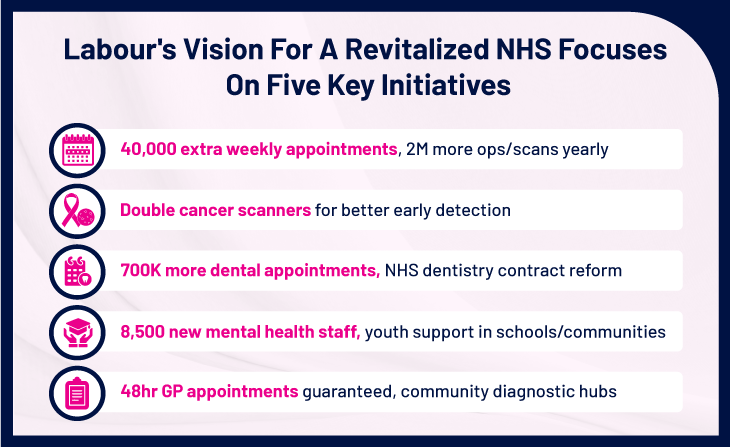Topics: AI in Recruitment, Healthcare Staffing, Labour Healthcare Reform, NHS Workforce Plan, UK Staffing Industry
£15 Billion Opportunity Knocks for UK Staffing Firms – But Can You Seize It?
Posted on August 12, 2024
Written By Abishek Balakumar

A Perfect Strom: NHS Workforce Plan, Labour’s Promises, and UK Staffing Solutions
July has now passed, marking the halfway point of 2024. Let us take a moment to review what transpired in July regarding the new Labour government’s key proposals for UK healthcare staffing and their potential implications.
What’s in it for the UK staffing firms?
The NHS could receive as much as £15 billion more funding over the next parliament if Labour takes steps to follow through on proposals for reform. A 20% rise in NHS staff numbers is expected to equate to roughly between an extra 20000 and 25000 healthcare professionals each year. QX along with industry leaders have discussed what a Labour win at the 2024 elections could mean for healthcare staffing in NHS England, during a recent webinar; industry leaders discussed the implications of the Labour Party’s victory in the 2024 elections for the NHS and healthcare staffing.

Key takeaways
- Ongoing staffing shortages and budget constraints, exacerbated by the uncertainty of Brexit and cost-of-living crisis.
- Potential for increased NHS funding under Labour, alongside challenges in talent acquisition.
- Importance of automation, technology, and standardized compliance to enhance efficiency and consistency across the NHS.

First NHS Long-Term Workforce Plan
The NHS Long-Term Workforce Plan, published in June 2023, profiles a broad strategy to address the demanding workforce challenges. We wanted to highlight 3 top things.
1. Strategic Focus Areas
The plan identifies three critical areas of focus to ensure a sustainable workforce:
Train
- Doubling medical school training places to 15,000 annually by 2031/32.
- Increasing GP training places by 50% to 6,000 by 2031/32.
- Expanding adult nursing training places by 92% to nearly 38,000 by 2031/32.
Retain
- Enhancing support for staff throughout their careers.
- Improving workplace culture and leadership within NHS organizations.
- Offering flexible working arrangements to accommodate staff needs.
Reform
- Building multidisciplinary teams with flexible skill sets.
- It will embrace innovations in technologies like artificial intelligence and robotic-assisted surgery.
- Reforming training programs to better align with the evolving needs of the healthcare system.
2. Emphasis on New Roles and Skills
- The plan aims to increase the proportion of staff in new roles, such as advanced practice positions, from 1% to 5%by the end of the plan period.
- It proposes to grow the number of NHS staff working in mental health, primary, and community care by 73% by 2036/37to enhance preventative and proactive care.
3. Commitment to Diversity and Wellbeing
The NHS workforce is becoming more diverse – 25% of staff are from ethnic minority groups. The plan also states all staff must have a “positive experience” and feel that they are important in work culture.

Winning our heritage in creating inclusive spaces, we hosted a “SheLeads: A Panel on Inclusive Leadership” webinar” webinar for the commitment from their professional odysseys and delve into the essence of womanhood and fostering inclusive workspaces. Helping build a more diverse organization that fosters inclusivity, the webinar discussed some of the struggles (and possible remedies) for women in leadership.
While we celebrate our improvements, nurse burnout remains a pressing issue.
According to the recent SIA report released on July 16, 2024, the main reasons nurses consider leaving the profession include:
- 2% cite mental health issues like stress and burnout as top reasons.
- 5% report unmanageable workloads as a primary factor.
- 2% feel undervalued or unsupported in their roles.
Experts emphasize the need for improved workplace support and mental well-being initiatives.
Key suggestions
Enhanced Shift Booking Systems: Implementing 100% Gen AI (Conversational AI) powered shift booking platforms can help nurses manage their schedules more effectively. This would allow them to choose shifts that fit their personal needs, potentially reducing stress and burnout associated with unmanageable workloads. This approach not only improves 80% of operational efficiency but also provides staff with opportunities aligned with their personal, mental and professional well-being, thereby enhancing job satisfaction and retention.
Streamlining Candidate Sourcing using AI Technologies: Demand for automated candidate sourcing and hiring processes is driving a £230 million market expansion between 2024 and 2028, according to Technavio. To this regard, staffing agencies have to raise their tempo in candidate sourcing by up to 50%, thereby improving the efficiency of recruitment and matching the ever-growing industry demands.
Compliance: In the forecast period, the healthcare compliance software market is projected to witness significant growth, with an anticipated £5.2 billion worth of growth from 2024 to 2033 and at a compound annual growth rate of 12.0%. It is anticipated that cloud-based solutions would form the trend in 2024 since they were already widely adopted among the health systems and hospitals as recently as 2020, coupled with robust data security features. The incorporation of blockchain technology for data integrity and the development of remote auditing solutions are emerging as key market trends.
Leverage Temporary Staffing Opportunities: According to SIA, on July 8, 2024, it is observed that the UK’s staffing industry is trending towards temporary placements amidst election uncertainty and a reduction in demand for permanent workers. Apply advanced advanced analytics / predictive analytics to forecast staffing needs by trend analysis using historical data, patient volumes, and seasonal trends. This enables proactive staffing, minimizing overstaffing or understaffing costs. Explore virtual staffing models for roles like telemedicine, remote patient monitoring, and administrative tasks. This expands the talent pool and reduces overhead costs.
Building Strong Client Relationships: Offer tailored staffing solutions based on client’s specific needs, such as rapid response teams for surge demands or specialized staffing for niche areas. Provide clients with valuable data insights on staffing trends, cost analysis, and performance metrics to demonstrate the value of your services.
Would you like to explore any of these areas in more detail, or perhaps focus on a specific challenge faced by healthcare staffing firms? Let’s take our conversation ahead.
Abishek Balakumar
Abishek is a marketing partner with over a half a decade of experience in B2B IT. With a passion for storytelling and a knack for marketing strategy, he crafts compelling narratives that resonate with our audience driving results through a team of 3.
Originally published Aug 12, 2024 11:08:14, updated Oct 31 2024
Topics: AI in Recruitment, Healthcare Staffing, Labour Healthcare Reform, NHS Workforce Plan, UK Staffing Industry








